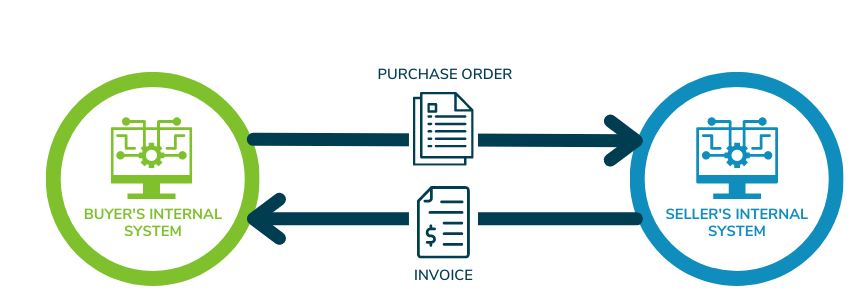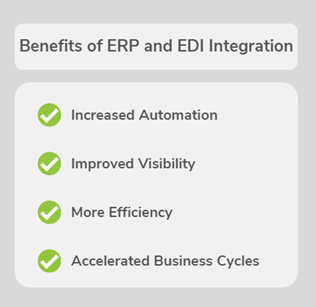
The saying “Communication is the key to success” has never been a more critical component to successful business relationships. That’s because in this connected global economy, supply chain collaboration and connection is integral to ensuring strong partner relationships and streamlined supply chain management.
If you’re a retailer, supplier or 3PL, chances are you need Electronic Data Interchange (EDI) technology to connect to your partners. Not sure where to start? Below, we look at how EDI works, who uses EDI software and the relationship between ERP and EDI systems. We’ve also included our recent webcast with SPS Commerce – our market-leading EDI partner – to show you how EDI technology can integrate with your Acumatica or Sage X3 solution.
What is EDI?
Electronic Data Interchange (EDI) software creates a data connection between two or more computers or devices. With this connection, users can quickly transfer business documents between companies, partners, suppliers or customers. EDI software translates documents to a unified format and provides standardized templates, so all documents and information are readily available and accessible.
EDI is integral for companies looking to automate their business processes. It replaces transactions, communications and order processing tasks that were typically done using paper or fax. EDI increases the accuracy and speed of communication and includes exchanging digital communications like invoices, purchase orders and advanced ship notices.
In concept, EDI is designed to standardize communications between you and your buyers, suppliers or logistics partners. In practice, however, experts at SPS Commerce (NexTec’s EDI partner) explain that there’s nothing standard about it; each organization manages EDI and utilizes it differently. That’s why SPS Commerce offers full-service EDI solutions to its customers (more on that later).
Who Uses EDI?
EDI users are typically divided into three major buckets:
- Retailers
- Suppliers
- Logistics or 3PL businesses
Each business type utilizes EDI and EDI automation differently. Let’s take a closer look:
1. Retailers
As a retailer, having a strong and reliable supply chain is critical. With EDI, you get the functionality you need to strengthen your supply chain, better serve customers and navigate disruptions. EDI software does this by improving communication between partners and internal staff and reducing time-consuming manual work like phone calls, faxes or emails.
Benefits of EDI for retailers includes:
- Automated supplier communication.
- Streamlined order fulfillment.
- Simplified order management.
- Improved warehouse management.
- Streamlined invoice reconciliation.
2. Suppliers
For suppliers, EDI works to automate order processing, saving you time and money. It does this by allowing orders to flow seamlessly through the processing cycle. Here’s how it works:
- A buying organization (think retailer, grocer or distributor) sends an electronic purchase order via EDI to its supplier.
- The supplier’s EDI system receives the order.
- The supplier uses EDI to send formal acknowledgement of the order and an accompanying invoice.

EDI replaces emails, phone calls and faxes and removes all manual intervention in the order processing workflow. The result is greater efficiency, less errors and improved trust and creditability with partners.
3. Third-Party Logistics (3PL) Providers
Your 3PL customers have unique needs, and each of their customers has unique shipping expectations, which makes exchanging relevant data and standardizing communications tough. Fortunately, EDI helps automate item, inventory, order and shipment data exchange with customers, regardless of whether they use EDI, spreadsheets or portals to share information.
Benefits of EDI for 3PL providers includes:
- Simplified communication with your customers.
- Easily accessible data, including item, inventory, delivery and order details.
- Automated data transfer to your WMS.
- One platform to manage it all.
How do ERP and EDI Fit Together?
Modern EDI solutions integrate with most modern Enterprise Resource Planning (ERP) solutions. The two work together by reducing manual, error-prone data entry, automating tasks and streamlining the process by which information is shared and communicated.
An ERP solution manages a business from end-to-end (including inventory, order management, sales, warehousing and more) and consolidates all data, processes and departments into a single unified system. EDI then works by harnessing the information in your ERP to communicate with internal and external resources in a more efficient, timely and concise way.
Here’s an example:
A customer’s stock is running low and more inventory is needed to fulfill impending orders. The customer’s ERP system is set up to create an automated purchase order (PO) for more inventory when stock levels reach a certain threshold. With ERP and EDI integration, that PO is then sent to the supplier without any manual intervention. The supplier receives the PO and starts processing the replenishment order without the need for multiple emails, phone calls, faxes or manual work.
Benefits of ERP and EDI Integration

1. Increased Automation
Because ERP automates most of a company’s back-office processes and EDI provides front-end connectivity between suppliers and partners, the two systems work together to improve efficiency and reduce errors.
2. Improved Visibility
With EDI and ERP integration, users get complete end-to-end visibility into their entire business. It improves supply chain management and allows business leaders to analyze their EDI data in combination with their ERP data, giving them ultimate control and insight.
3. More Efficiency
The two systems work together to create more efficiencies, reducing the time it takes to process orders and respond to issues.
4. Accelerated Business Cycles
Leaders who utilize ERP and EDI tools can automate pipelines and optimize processes by integrating supply chain data like available stock, supply projections and warehouse capacity to automate responsive supply chain processes and accelerate business cycles.
NexTec and SPS Commerce – Your ERP and EDI Partners
For our Sage X3 and Acumatica ERP customers, SPS Commerce is the industry’s leading EDI partner. SPS Commerce is unique in that it offers full-service EDI solutions, meaning that all of the heavy lifting is done for you. The SPS Commerce team takes care of the design and configuration of your EDI system as well as go-live steps that include testing and launch, and ongoing access to critical resources. To learn more about SPS Commerce, check out our on-demand webcast below.
For more information or a free demo of NexTec’s ERP solutions, reach out to us.
Conclusion
Leading companies rely on ERP and EDI integration to get ahead. If you’re a retailer, supplier or 3PL and are struggling to simplify the exchange of supply chain data, EDI software may be the right solution for you.
